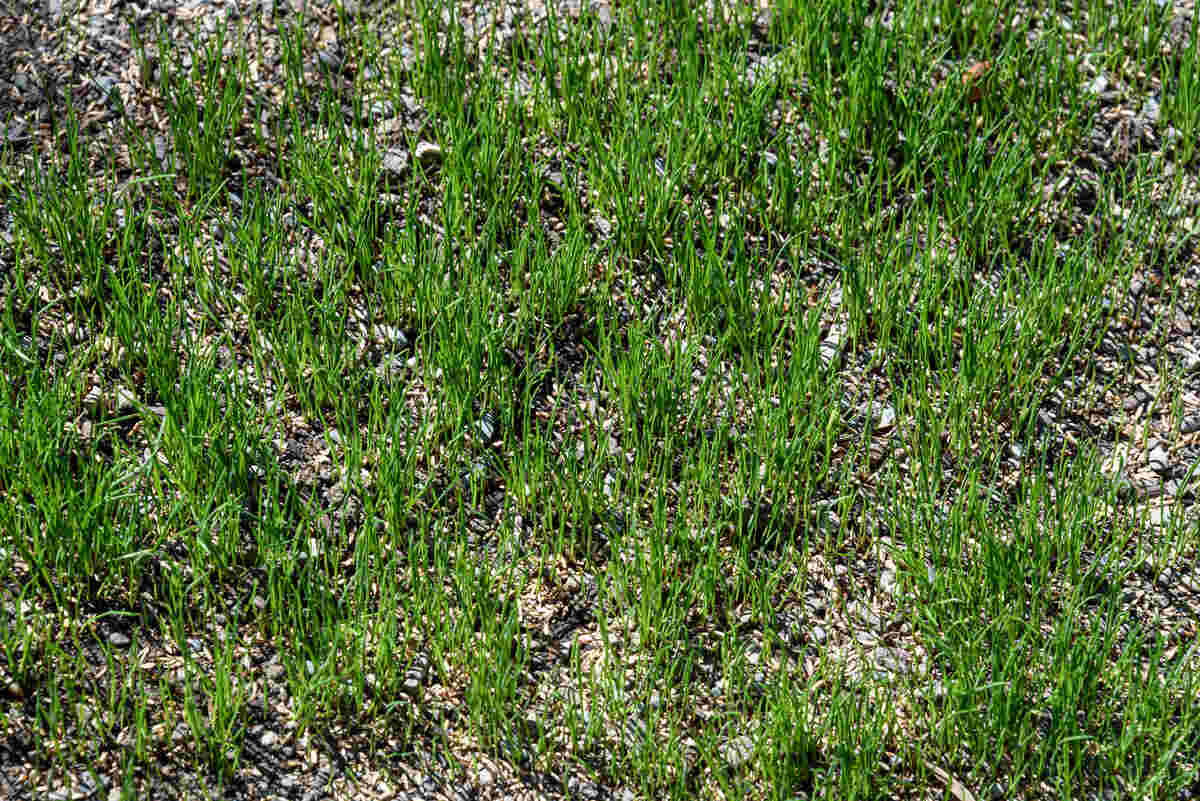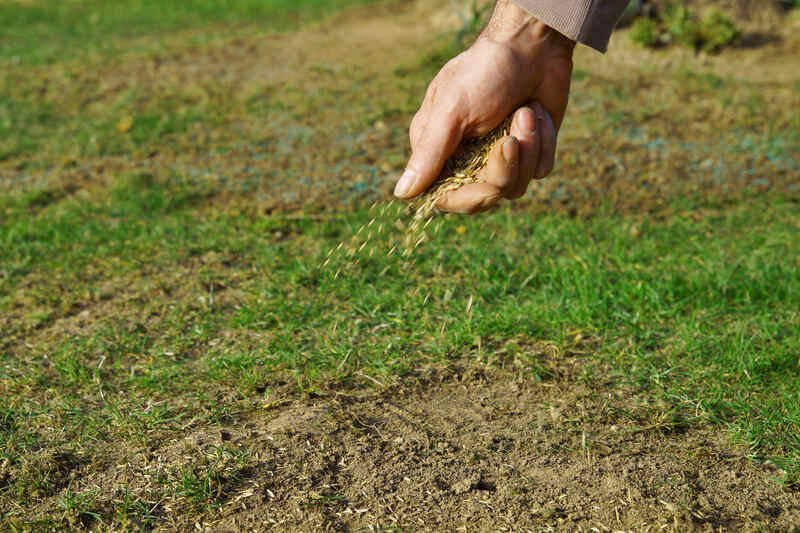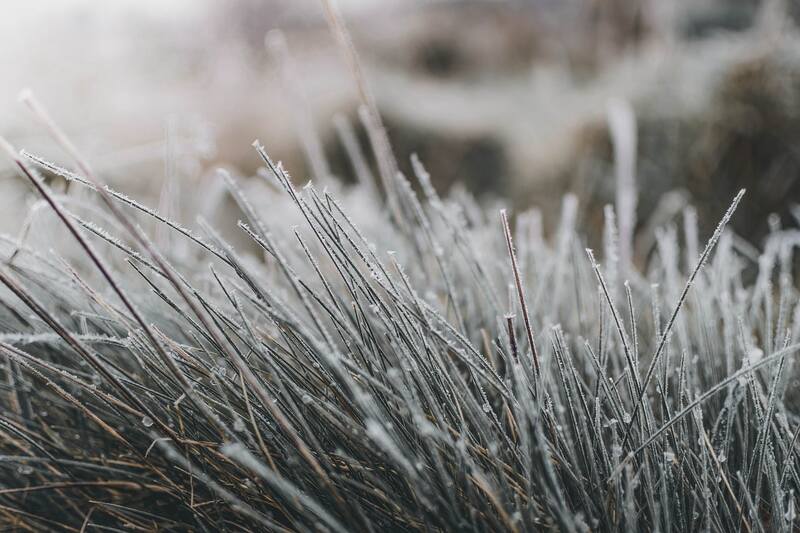
Dormant seeding involves planting grass seeds in cold, unfrozen soil in late fall. The seeds lay dormant through the winter, then swiftly sprout in early spring.
It’s a savvy lawn care strategy for maintaining a lush lawn. As soon as the snow melts and the soil warms, seedlings emerge. New grass fills barren patches and adds thickness to the lawn. Now, there’s no need to struggle sowing in the spring.
How Does Dormant Seeding Work?

Dormant seeding makes the most out of Mother Nature. Like all her children, grass seeds have innate traits that give their species the best shot at survival. Winter dormancy delays germination, allowing seeds to sprout once they have a healthy chance to mature.
When the season changes, the spring sun warms the soil and melts the snow. Now hydrated and heated, the earth is geared up for growth. Since seeds are already in the soil, they start sprouting before spring sowing begins.
Overseeding right before the freeze works best with the right weather:
- Seeds are sown in 45°F to 50°F soil. Thus, the air is 35°F to 40°F. This typically occurs in late October to early December. The soil should be too cold for germination but not frozen.
- Dormant seeding works best when winter weather is consistently cold. Seeds may sprout too soon if the temperature fluctuates and the soil warms up. When bitter winter weather returns, the young seedlings will likely die.
- There are a few inches of snow covering the soil for the entire winter. The snow provides insulation and protection to the dormant seeds. It’s also an instant water source come spring.
Additionally, proper preparation is paramount to encourage seed-to-soil contact.
Best Grass Seed for Dormant Seeding
Mother Nature made cool-season grass seeds with the winter-to-spring transition in mind. Its best to seed with cool-season mixes that contain one or more of the following:
- Fescue: Fine fescue and tall fescue are excellent options for dormant seeding. Being cold-hardy and shade tolerant, fescues favor fall seeding.
- Kentucky bluegrass: Homeowners covet Kentucky bluegrass‘s density and deep green color. Its resilience relies on dormancy during extreme weather.
- Perennial ryegrass: Many fall seed mixes contain perennial ryegrass because it is the quickest to establish. It also has a high tolerance for foot traffic, making it great for families with children or pets.
- Native grass: Dormant seeding is based on nature’s rhythm. Native grass seeds naturally sync with your local climate.
Pros & Cons of Dormant Seeding
| Pros | Cons |
| ✓ Improves lawn density ✓ Fills bare spots with grass in early spring ✓ Grass seeds establish sooner in spring ✓ Soil is typically easier to prep in the fall ✓ Requires less watering in the early stages ✓ Seedlings have fewer weeds to compete with ✓ Deep roots develop before harsh summer weather starts | ✗ Germination rate is lower than general overseeding ✗ Success is determined by weather ✗ Ineffective on dense, healthy lawns ✗ If the lawn’s still thin, you must seed again in spring ✗ Many crabgrass-killing pre-emergent herbicides harm the new grass that sprouts in early spring |
Dormant Seeding vs. Frost Seeding vs. General Seeding

The best time to plant grass seeds depends on your location, grass type, and schedule. There are three different ways to seed your lawn:
- As we talked about above, dormant seeding is done in late fall before the soil freezes. It works best on cool-season grasses in northern states.
- Frost seeding occurs in late winter after the soil freezes. It works best on pastures of cool-season grass with predictable winter weather. As livestock tramples the terrain, seeds penetrate the frozen soil. The USDA says that frost seeding is the cheapest and most energy-efficient seeding method.
- General seeding occurs in the growing season. The best time for cool-season grass is early fall, and the best time for warm-season grass is in the spring. General seeding has a higher success rate than dormant or frost seeding, but seeds sprout later in the season.
FAQ about dormant seeding
How do you dormant seed your lawn?
It’s easy to learn how to dormant seed your lawn. It just takes a few simple steps:
- Clean your yard
- Loosen the soil
- Sow the seeds
- Water the ground
- Wait out the winter
- See sprouting in spring
It’s typically easier to prepare the soil for overseeding in late fall than early spring because the ground is drier. There are also less lawn care tasks to juggle.
How long can grass seeds lay dormant?
Grass seeds can lay dormant for many months, with some species staying viable for up to two to three years.
Is slice seeding or dormant seeding better?
Slice seeding is the best method for total lawn restoration and dormant seeding is best for spot fixing cool-season grass. Slice seeding maximizes seed-to-soil contact using a specialized machine.
Hiring a Lawn Treatment Pro
If you don’t want to bear the burden of grueling yard work, consider hiring a lawn treatment pro. LawnStarter links you to experts who make your lawn look lush. Our rates are affordable, and our pros are insured. We offer easy online ordering for over 30 outdoor services, including mowing, seeding, and landscape design.
Sources:
- Browning, Sarah. “Dormant Lawn Seeding.” Nebraska Extension in Lancaster County. University of Nebraska Lincoln
- “Discuss the steps in seedbed preparation“. Forage Information System. Oregon State University
- “Dormant seeding your lawn“. University of Minnesota Extension
- “Frost Seeding.” Illinois Grazing Manual Fact Sheet. United States Department of Agriculture
- Murphy, Jim. (2023, February 20). “Mild winter, what does it mean for overseeding of turf or dormant seeding?“. Center for Turfgrass Science. Rutgers, The State University of New Jersey
Main Photo Credit: knelson20 / Adobe Stock Free / License